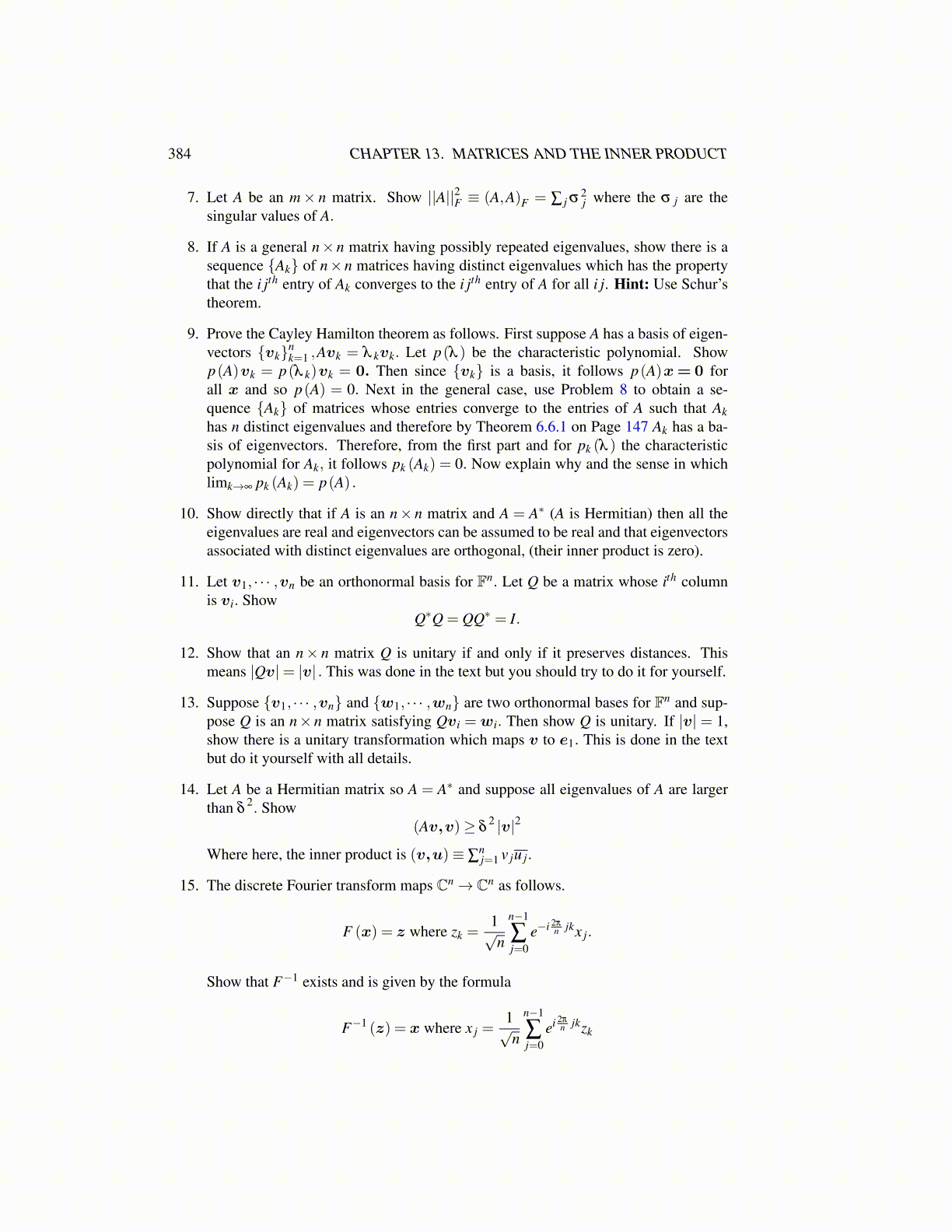
384 CHAPTER 13. MATRICES AND THE INNER PRODUCT
7. Let A be an m× n matrix. Show ||A||2F ≡ (A,A)F = ∑ j σ2j where the σ j are the
singular values of A.
8. If A is a general n× n matrix having possibly repeated eigenvalues, show there is asequence {Ak} of n×n matrices having distinct eigenvalues which has the propertythat the i jth entry of Ak converges to the i jth entry of A for all i j. Hint: Use Schur’stheorem.
9. Prove the Cayley Hamilton theorem as follows. First suppose A has a basis of eigen-vectors {vk}n
k=1 ,Avk = λ kvk. Let p(λ ) be the characteristic polynomial. Showp(A)vk = p(λ k)vk = 0. Then since {vk} is a basis, it follows p(A)x= 0 forall x and so p(A) = 0. Next in the general case, use Problem 8 to obtain a se-quence {Ak} of matrices whose entries converge to the entries of A such that Akhas n distinct eigenvalues and therefore by Theorem 6.6.1 on Page 147 Ak has a ba-sis of eigenvectors. Therefore, from the first part and for pk (λ ) the characteristicpolynomial for Ak, it follows pk (Ak) = 0. Now explain why and the sense in whichlimk→∞ pk (Ak) = p(A) .
10. Show directly that if A is an n× n matrix and A = A∗ (A is Hermitian) then all theeigenvalues are real and eigenvectors can be assumed to be real and that eigenvectorsassociated with distinct eigenvalues are orthogonal, (their inner product is zero).
11. Let v1, · · · ,vn be an orthonormal basis for Fn. Let Q be a matrix whose ith columnis vi. Show
Q∗Q = QQ∗ = I.
12. Show that an n× n matrix Q is unitary if and only if it preserves distances. Thismeans |Qv|= |v| . This was done in the text but you should try to do it for yourself.
13. Suppose {v1, · · · ,vn} and {w1, · · · ,wn} are two orthonormal bases for Fn and sup-pose Q is an n× n matrix satisfying Qvi =wi. Then show Q is unitary. If |v| = 1,show there is a unitary transformation which maps v to e1. This is done in the textbut do it yourself with all details.
14. Let A be a Hermitian matrix so A = A∗ and suppose all eigenvalues of A are largerthan δ
2. Show(Av,v)≥ δ
2 |v|2
Where here, the inner product is (v,u)≡ ∑nj=1 v ju j.
15. The discrete Fourier transform maps Cn→ Cn as follows.
F (x) = z where zk =1√n
n−1
∑j=0
e−i 2πn jkx j.
Show that F−1 exists and is given by the formula
F−1 (z) = x where x j =1√n
n−1
∑j=0
ei 2πn jkzk